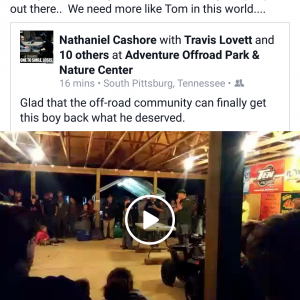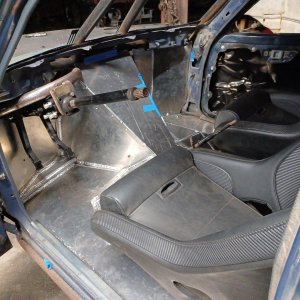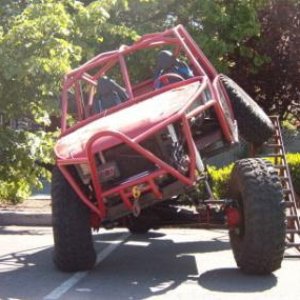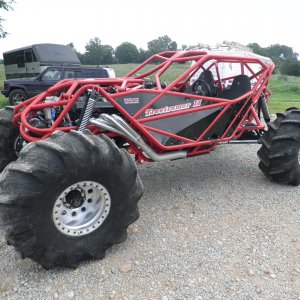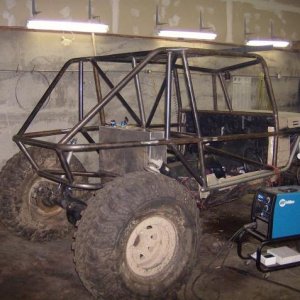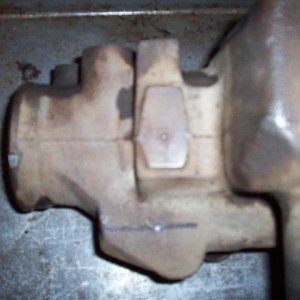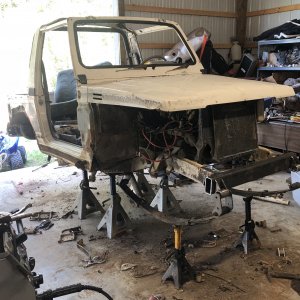-
Help Support Hardline Crawlers :
You are using an out of date browser. It may not display this or other websites correctly.
You should upgrade or use an alternative browser.
You should upgrade or use an alternative browser.
starter problem
- Thread starter s10truggy
- Start date
doctordick
Classic American Iron, son.
THE DREADED "HEAT SOAK" Summit Racing has heat shields to mount on a full size starter. Another alternative is to run the small gear drive type starter and turn the body upside down so the solenoid is on the bottom away from the header tubes. If you're not familiar with tearing down a starter, take it to an auto electric shop and have them do it. If you're in the Dora/Sumiton area, let me know, I'll be glad to do it for you.
badreligion_13
Well-Known Member
- Joined
- Aug 20, 2008
- Messages
- 258
A much better solution than any heat shield is this remote solenoid kit.. I have been using two of these for 20 years on two different vehicles with not one bit of a problem with starting while using headers.
http://www.summitracing.com/parts/SUM-G1750/
http://www.summitracing.com/parts/SUM-G1750/
doctordick
Classic American Iron, son.
A remote solenoid (actually a relay) is a help in that it will provide higher current to the solenoid and starter motor. It does not resolve the problem of the solenoid coil on the starter absorbing heat which results in higher resistance and therefore higher current demand. From a practical standpoint, try a heat shield first, they're cheap and quick to install. If that doesn't resolve the problem add a remote solenoid (relay) kit. As a final solution, try the upside-down mini starter. Another advantage of a mini-starter is that they require less current to operate making them less susceptible to heat soak. Also their small size keeps the motor and solenoid farther away from the headers.badreligion_13 said:A much better solution than any heat shield is this remote solenoid kit.. I have been using two of these for 20 years on two different vehicles with not one bit of a problem with starting while using headers.
http://www.summitracing.com/parts/SUM-G1750/
I'd suggest that before you start on all the above, have your starter checked for current draw and bushing condition. GM starters are notorious for the armature bushings wearing and expanding when hot allowing the armature in the motor to pull out of line causing the infamous "rump-rumps" when hot. By the way, you might want to check your timing, too much initial advance will cause a similar symptom.
doctordick said:A remote solenoid (actually a relay) is a help in that it will provide higher current to the solenoid and starter motor. It does not resolve the problem of the solenoid coil on the starter absorbing heat which results in higher resistance and therefore higher current demand.
That was my ?, does that kit eliminate the solenoid from the starter? If not I see what your saying exactly.
doctordick
Classic American Iron, son.
jkh533 said:That was my ?, does that kit eliminate the solenoid from the starter? If not I see what your saying exactly.
No, it doesn't
tommyswheelin
Well-Known Member
- Joined
- Dec 21, 2011
- Messages
- 230
Check your grounds. From motor to frame . Frame to body. Battery to body. We had this problem on race car.
doctordick
Classic American Iron, son.
Good idea 

badreligion_13
Well-Known Member
- Joined
- Aug 20, 2008
- Messages
- 258
doctordick said:A remote solenoid (actually a relay) is a help in that it will provide higher current to the solenoid and starter motor. It does not resolve the problem of the solenoid coil on the starter absorbing heat which results in higher resistance and therefore higher current demand. From a practical standpoint, try a heat shield first, they're cheap and quick to install. If that doesn't resolve the problem add a remote solenoid (relay) kit. As a final solution, try the upside-down mini starter. Another advantage of a mini-starter is that they require less current to operate making them less susceptible to heat soak. Also their small size keeps the motor and solenoid farther away from the headers.
I'd suggest that before you start on all the above, have your starter checked for current draw and bushing condition. GM starters are notorious for the armature bushings wearing and expanding when hot allowing the armature in the motor to pull out of line causing the infamous "rump-rumps" when hot. By the way, you might want to check your timing, too much initial advance will cause a similar symptom.
It bypasses the starter solenoid with a jumper on the starter solenoid that connects each terminal on the solenoid together so you do NOT have to rely on the starter solenoid. The starter can get hot all day long and it will not matter as long as you have a current going to it,This from practical experience over 20 years of using them on small block chevys with headers. I have watched engines get hot and not start. Yet, the the moment you switch to the remote solenoid the problem is NEVER seen again.
A heat shield is a WASTE OF TIME and money. If you want to waste time having your starter checked go ahead...Or buy a 20 dollar solenoid bypass kit and never have the problem again.
doctordick
Classic American Iron, son.
Okay, so WTF is that big round thing on top of the starter motor? It's a F'n SOLENOID. It pulls in to engage the drive to the flywheel, therefore if you eliminate it, the starter motor will run but never engage the drive!!!! Adding a remote relay does absolutely nothing to prevent the solenoid coil from absorbing heat which causes higher resistance which requires higher current for the solenoid plunger to engage the drive. What a remote relay does is provide more current to the solenoid coil. Sometimes that is all that is required to resolve the problem, but not always. I don't care how much add on **** you throw at a bad starter, it ain't gonna work right if it's ****ed up so why not take it to a parts store and have it tested, that's just common sense. Relay kit won't fix a bad bushing.
You can be a parts changer or a technician, the choice is yours but you'll save yourself time, headaches and money if you use a logical approach to resolving the problem instead of just slingin'**** at it. Just maybe the reason a heat shield didn't work for badattitude_13 is that his starter was bad
By the way, badattitude, I have a degree in Electronics Engineering technology and have been building engines for about 50 years now. I converted that old Willys in my avatar to TBI more than 15 years ago before you could buy an aftermarket harness and I spent 15 years teaching guys to troubleshoot and repair complex electronic controls of mechanical equipment. I do know what I'm talking about and I enjoy sharing what I've learned.
You can be a parts changer or a technician, the choice is yours but you'll save yourself time, headaches and money if you use a logical approach to resolving the problem instead of just slingin'**** at it. Just maybe the reason a heat shield didn't work for badattitude_13 is that his starter was bad

By the way, badattitude, I have a degree in Electronics Engineering technology and have been building engines for about 50 years now. I converted that old Willys in my avatar to TBI more than 15 years ago before you could buy an aftermarket harness and I spent 15 years teaching guys to troubleshoot and repair complex electronic controls of mechanical equipment. I do know what I'm talking about and I enjoy sharing what I've learned.
Regardless if the solenoid fixes the problem or not it fixed mine. I used to burn up a starter every couple rides. I added a ford solenoid and it helped, since then I built my new motor a put on a gear reduction mini starter along with the remote solenoid and still have no problems.
DD here's a cookie
DD here's a cookie
Attachments
doctordick
Classic American Iron, son.
THANK YOU, GOT ANY MILK? 



badreligion_13
Well-Known Member
- Joined
- Aug 20, 2008
- Messages
- 258
doctordick said:Okay, so WTF is that big round thing on top of the starter motor? It's a F'n SOLENOID. It pulls in to engage the drive to the flywheel, therefore if you eliminate it, the starter motor will run but never engage the drive!!!! Adding a remote relay does absolutely nothing to prevent the solenoid coil from absorbing heat which causes higher resistance which requires higher current for the solenoid plunger to engage the drive. What a remote relay does is provide more current to the solenoid coil. Sometimes that is all that is required to resolve the problem, but not always. I don't care how much add on **** you throw at a bad starter, it ain't gonna work right if it's ****ed up so why not take it to a parts store and have it tested, that's just common sense. Relay kit won't fix a bad bushing.
You can be a parts changer or a technician, the choice is yours but you'll save yourself time, headaches and money if you use a logical approach to resolving the problem instead of just slingin'**** at it. Just maybe the reason a heat shield didn't work for badattitude_13 is that his starter was bad
By the way, badattitude, I have a degree in Electronics Engineering technology and have been building engines for about 50 years now. I converted that old Willys in my avatar to TBI more than 15 years ago before you could buy an aftermarket harness and I spent 15 years teaching guys to troubleshoot and repair complex electronic controls of mechanical equipment. I do know what I'm talking about and I enjoy sharing what I've learned.
Your an engineer. That explains a lot. You are not seeing the forest from the tree which is typical of your profession. Translation, you above ADMIT the solenoid bypass does work; BUT, then you throw in" not on all starters" because some are bad. You would be right to an extent, that is a bad a starter is a bad starter. However, that sure is a big assumption and or blanket statement to presume that all starter that have this problem must be a BAD starter for you to continue arguing.
My starter that you felt was bad, not so much. Bypass solenoid added, after failed heat shield, what do you know, it still works 18 years later! Must not be bad ,huh?

doctordick
Classic American Iron, son.
Truggy-dood, good luck with your starter problem, hope you get it whipped.  I'm going to go eat my cookie now.
I'm going to go eat my cookie now. 
 I'm going to go eat my cookie now.
I'm going to go eat my cookie now. 



